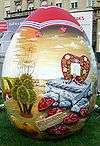Easter egg
Easter eggs, also called Paschal eggs,[1] are decorated eggs that are often given to celebrate Easter or springtime. As such, Easter eggs are common during the season of Eastertide (Easter season). The oldest tradition is to use dyed and painted chicken eggs, but a modern custom is to substitute chocolate eggs, or plastic eggs filled with confectionery such as chocolate. Eggs, in general, were a traditional symbol of fertility, and rebirth.[2]
History
The practice of decorating eggshells is ancient, predating Christian traditions.[3] Ostrich eggs with engraved decoration that are 60,000 years old have been found in Africa.[4] Decorated ostrich eggs, and representations of ostrich eggs in gold and silver, were commonly placed in graves of the ancient Sumerians and Egyptians as early as 5,000 years ago.[5]
The Christian custom of the Easter egg, can be traced as far back as the early Christians of Mesopotamia, who stained eggs red in memory of the blood of Christ.[6][7] The Christian Church officially adopted the custom, regarding the eggs as a symbol of the resurrection. The Roman Ritual, the first edition of which was published in 1610 but which contains texts of much older date, has among the Easter Blessings of Food, along with those for lamb, bread, and new produce, the following blessing for eggs:[6][7]
Lord, let the grace of your blessing + come upon these eggs, that they be healthful food for your faithful who eat them in thanksgiving for the resurrection of our Lord Jesus Christ, who lives and reigns with you forever and ever.[8]
Although the tradition is to use dyed or painted chicken eggs, a modern custom is to substitute chocolate eggs, or plastic eggs filled with candy such as jelly beans. These eggs can be hidden for children to find on Easter morning, which may be left by the Easter Bunny. They may also be put in a basket filled with real or artificial straw to resemble a bird's nest.
Lenten tradition


The Easter egg tradition may also have merged into the celebration of the end of the privations of Lent in the West. Historically, it was traditional to use up all of the household's eggs before Lent began. Eggs were originally forbidden during Lent as well as on other traditional fast days in Western Christianity (this tradition still continues among the Eastern Christian Churches). Likewise, in Eastern Christianity, meat, eggs, and dairy are all prohibited during the Lenten fast.
This established the tradition of Pancake Day being celebrated on Shrove Tuesday. This day, the Tuesday before Ash Wednesday when Lent begins, is also known as Mardi Gras, a French phrase which translates as "Fat Tuesday" to mark the last consumption of eggs and dairy before Lent begins.
In the Orthodox Church, Great Lent begins on Clean Monday, rather than Wednesday, so the household's dairy products would be used up in the preceding week, called Cheesefare Week.
During Lent, since chickens would not stop producing eggs during this time, a larger than usual store might be available at the end of the fast. This surplus, if any, had to be eaten quickly to prevent spoiling. Then, with the coming of Easter, the eating of eggs resumes. Some families cook a special meatloaf with eggs in it to be eaten with the Easter dinner.[9]
One would have been forced to hard boil the eggs that the chickens produced so as not to waste food, and for this reason the Spanish dish hornazo (traditionally eaten on and around Easter) contains hard-boiled eggs as a primary ingredient. In Hungary, eggs are used sliced in potato casseroles around the Easter period.
Decoration and symbolism
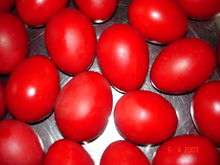
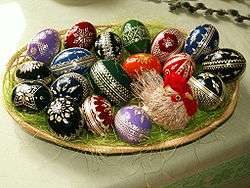

In the Orthodox and Eastern Catholic Churches, Easter eggs are dyed red to represent the blood of Christ, shed on the Cross, and the hard shell of the egg symbolized the sealed Tomb of Christ — the cracking of which symbolized his resurrection from the dead. Easter eggs are blessed by the priest at the end of the Paschal Vigil (which is equivalent to Holy Saturday), and distributed to the faithful. The egg is seen by followers of Christianity as a symbol of resurrection: while being dormant it contains a new life sealed within it.[10][11]
Similarly, in the Roman Catholic Church in Poland, the so-called święconka, i.e. blessing of decorative baskets with a sampling of Easter eggs and other symbolic foods, is one of the most enduring and beloved Polish traditions on Holy Saturday.
During Paschaltide, in some traditions the Pascal greeting with the Easter egg is even extended to the deceased. On either the second Monday or Tuesday of Pascha, after a memorial service people bring blessed eggs to the cemetery and bring the joyous paschal greeting, "Christ has risen", to their beloved departed (see Radonitza).
Easter eggs are a widely popular symbol of new life in Bulgaria, Poland, Romania, Russia, Ukraine, and other Central European countries' folk traditions, which include concealing them in the garden for children to find, and making artificial eggs out of porcelain for ladies.[12]:45 A batik (wax resist) process is used to create intricate, brilliantly colored eggs, the best-known of which is the Ukrainian pysanka and the Polish pisanka. The celebrated Fabergé workshops created exquisite jeweled Easter eggs for the Russian Imperial Court. Most of these creations themselves contained hidden surprises such as clock-work birds, or miniature ships. A 27-foot (9 m) sculpture of a pysanka stands in Vegreville, Alberta.
There are many other decorating techniques and numerous traditions of giving them as a token of friendship, love or good wishes. A tradition exists in some parts of the United Kingdom (such as Scotland and North East England) of rolling painted eggs down steep hills on Easter Sunday. In the U.S., such an Easter egg roll (unrelated to an eggroll) is often done on flat ground, pushed along with a spoon; the Easter Egg Roll has become a much-loved annual event on the White House lawn. An Easter egg hunt is a common festive activity, where eggs are hidden outdoors (or indoors if in bad weather) for children to run around and find. This may also be a competition to see who can collect the most eggs.
When boiling eggs for Easter, a tan colour can be achieved by boiling the eggs with onion skins. Easter eggs are often dyed red through a process of boiling them with onion skins.[13] When boiling them with onion skins leaves can be attached prior to dying to create leaf patterns. The leaves are attached to the eggs before they are dyed with a transparent cloth to wrap the eggs with like inexpensive muslin or nylon stockings, leaving patterns once the leaves are removed after the dyeing process.[14][15] These eggs are part of Easter custom in many areas and often accompany other traditional Easter foods. Passover haminados are prepared with similar methods. A greater variety of colour was often provided by tying on the onion skin with different coloured woollen yarn. In the North of England these are called pace-eggs or paste-eggs, from a dialectal form of Middle English pasche. They were usually eaten after an egg-jarping (egg tapping) competition. Natural colours are obtained by using various plants:
- brown: onion peels;
- black: oak or alder bark or the nutshell of walnut;
- golden: the bark of young apple tree or the marigold flower;
- violet: petals of the mallow flower;
- green: shoots of young rye or leaves of periwinkle;
- pink: beet juice.
In Italy, chocolate eggs with a surprise inside have largely replaced the traditional Easter eggs.
Easter egg traditions


An egg hunt is a game during which decorated eggs, real hard-boiled ones or artificial ones filled with, or made of chocolate candies, of various sizes, are hidden for children to find, both indoors and outdoors.[16] When the hunt is over, prizes may be given for the largest number of eggs collected, or for the largest or the smallest egg.[16] Real eggs may further be used in egg tapping contests.
In the North of England, during Eastertide, a traditional game is played where hard boiled pace eggs are distributed and each player hits the other player's egg with their own. This is known as "egg tapping", "egg dumping" or "egg jarping". The winner is the holder of the last intact egg. The losers get to eat their eggs. The annual egg jarping world championship is held every year over Easter in Peterlee Cricket Club. It is also practised in Italy where is called Scuccetta (Mainly in Marche Region), Bulgaria, Hungary, Croatia, Latvia, Lithuania, Lebanon, Macedonia, Romania, Serbia, Ukraine, and other countries. In parts of Austria, Bavaria and German-speaking Switzerland it is called Ostereiertitschen or Eierpecken. In parts of Europe it is also called epper, presumably from the German name Opfer, meaning "offering" and in Greece it is known as tsougrisma. In South Louisiana this practice is called Pocking Eggs[17][18] and is slightly different. The Louisiana Creoles hold that the winner eats the eggs of the losers in each round.
The central European Slavic nations (Czechs and Slovaks etc.) have a tradition of gathering eggs by gaining them from the females in return of whipping them with a pony-tail shaped whip made out of fresh willow branches and splashing them with water, by the Ruthenians called polivanja, which is supposed to give them health and beauty.
Egg rolling is also a traditional Easter egg game played with eggs at Easter. In the United Kingdom, Germany, and other countries children traditionally rolled eggs down hillsides at Easter.[19] This tradition was taken to the New World by European settlers,[19][20] and continues to this day each Easter on the White House lawn. Different nations have different versions of the game.
Egg dance is a traditional Easter game in which eggs are laid on the ground or floor and the goal is to dance among them without damaging any eggs[21] which originated in Germany. In the UK the dance is called the hop-egg.
The Pace Egg plays are traditional village plays, with a rebirth theme. The drama takes the form of a combat between the hero and villain, in which the hero is killed and brought to life, The plays take place in England during Easter.
In some Mediterranean countries, especially in Lebanon, chicken eggs are boiled and decorated by dye and/or painting and used as decoration around the house. Then, on Easter Day, young kids would duel with them saying 'Christ is resurrected, Indeed He is', breaking and eating them. This also happens in Bulgaria, Macedonia, Serbia, Russia, Ukraine, Greece and Cyprus (where the eggs are painted red). In Easter Sunday friends and family hit each other's egg with their own. The one whose egg does not break is believed to be in for good luck in the future.
In Germany, eggs decorate trees and bushes as Easter egg trees, and in several areas public wells as Osterbrunnen.
In Egypt, it's a tradition to decorate boiled eggs during Sham el-Nessim holiday, which falls every year after the Eastern Christian Easter.
Cascarones, a Latin American tradition now shared by many US States with high Hispanic demographics, are an emptied and dried chicken egg stuffed with confetti and sealed with a piece of tissue paper. The eggs are hidden in a similar tradition to the American Easter egg hunt and when found the children (and adults) break them over each other's heads.
Each year 80 million easter eggs are sold in the UK alone.[22]
In Greece, women traditionally dye the eggs with onion skins and vinegar on Thursday (also the day of Communion). These ceremonial eggs are known as kokkina avga. They also bake tsoureki for the Easter Sunday feast.[23] Red Easter eggs are sometimes served along the centerline of tsoureki (braided loaf of bread).[24][25] A traditional game is for two people to smash the eggs together- the winner is the one whose egg remains intact. The red eggs are also cracked together when people exchange Easter greetings.
Easter eggs types and regional variants
Pysanky

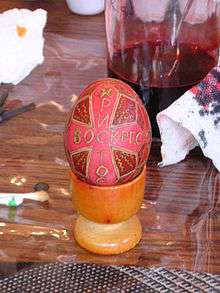
A pysanka is a Ukrainian Easter egg, decorated using a wax-resist (batik) method. Many other eastern European ethnic groups decorate eggs using wax resistant batik methods for Easter. The word comes from the verb pysaty, "to write", as the designs are not painted on, but written with beeswax. On Easter Sunday, families bring baskets with krashanky, pysanky, paska and meat to be blessed. These are eaten upon returning home when the traditional fasting period is broken with a celebration.[26]
Pysanky are typically made to be given to family members and respected outsiders. To give a pysanka is to give a symbolic gift of life, which is why the egg must remain whole. Furthermore, each of the designs and colors on the pysanka is likely to have a deep, symbolic meaning. Traditionally, the designs are chosen to match the character of the person to whom the pysanka is to be given.
At one time, in a large family by Maundy Thursday 60 or more eggs would have been completed by the women of the house. (The more daughters a family had, the more pysanky would be produced.) The eggs would then be taken to the church on Easter Sunday to be blessed, after which they were given away. Here is a partial list of how the pysanky would be used:
- One or two would be given to the priest.
- Three or four were taken to the cemetery and placed on graves of the family.
- Ten or fifteen were given to children or godchildren.
- Ten or twelve were exchanged by the unmarried girls with the eligible men in the community.
- Several were saved to place in the coffin of loved ones who might die during the year.
- Several were saved to keep in the home for protection from fire, lightning and storms.
- Two or three were placed in the mangers of cows and horses to ensure safe calving and colting and a good milk supply for the young.
- At least one egg was placed beneath the bee hive to insure a good harvest of honey.
- One was saved for each grazing animal to be taken out to the fields with the shepherds in the spring.
- Several pysanky were placed in the nests of hens to encourage the laying of eggs.
Everyone from the youngest to the oldest received a pysanka for Easter. Young people were given pysanky with bright designs; dark pysanky were given to older people.
A bowl full of pysanky was invariably kept in every home. It served not only as a colorful display, but also as protection from all dangers. Some of the eggs were emptied, and a bird’s head made of wax or dough and wings and tail-feathers of folded paper were attached. These “doves” were suspended before icons in commemoration of the birth of Christ, when a dove came down from heaven and soared over the child Jesus.
Many superstitions were attached to pysanky. Pysanky were thought to protect households from evil spirits, catastrophe, lightning and fires. Pysanky with spiral motifs were the most powerful, as the demons and other unholy creatures would be trapped within the spirals forever. A blessed pysanka could be used to find demons hidden in the dark corners of the house. Pysanky held powerful magic, and had to be disposed of properly. The eggshell had to be ground up very finely (and fed to chickens to make them good egg layers) or broken into pieces and tossed into a running stream. It was considered very bad luck to trample on a pysanka.[27]
The color palette of traditional pysanky was fairly limited, and based on natural dyes. Yellow, red/orange, green, brown and black were the predominant colors. With the advent of aniline dyes in the 1800s, small amounts of blue and purple were sometimes added. It is important to note that the meanings below are generalizations; different regions interpreted colors differently.
- Red - is probably the oldest symbolic color, and has many meanings. It represents life-giving blood, and often appears on pysanky with nocturnal and heavenly symbols. It represents love and joy, and the hope of marriage.
- Yellow - symbolized the moon and stars and also, agriculturally, the harvest. It is also associated with the sun.
- Blue - Represented blue skies or the air, and good health.
- White - Signified purity, birth, light, rejoicing, virginity.
- Green - the color of new life in the spring. Green represents the resurrection of nature, and the riches of vegetation.[28]
Legends
Christian traditions
While the origin of Easter eggs can be explained in the symbolic terms described above, among followers of Eastern Christianity the legend says that Mary Magdalene was bringing cooked eggs to share with the other women at the tomb of Jesus, and the eggs in her basket miraculously turned bright red when she saw the risen Christ. [29]
A different, but not necessarily conflicting legend concerns Mary Magdalene's efforts to spread the Gospel. According to this tradition, after the Ascension of Jesus, Mary went to the Emperor of Rome and greeted him with "Christ has risen," whereupon he pointed to an egg on his table and stated, "Christ has no more risen than that egg is red."
After making this statement it is said the egg immediately turned blood red.[30] Red Easter eggs', known as kokkina avga(κόκκινα αυγά) in Greece and krashanki in Ukraine, are an Easter tradition and a distinct type of Easter egg prepared by various Orthodox Christian peoples.[31][32][33][34] The red eggs are part of Easter custom in many areas and often accompany other traditional Easter foods. Passover haminados are prepared with similar methods. Dark red eggs are a tradition in Greece and represent the blood of Christ shed on the cross.[35] The practice dates to the early Christian church in Mesopotamia.[6][7] In Greece, superstitions of the past included the custom of placing the first-dyed red egg at the home's iconostasis (place where icons are displayed) to ward off evil. The heads and backs of small lambs were also marked with the red dye to protect them.
-
Easter eggs from Ukraine
-

Belarusian Easter Eggs.
-

A mix of traditional and modern Pysaka
-

Easter eggs from Sorbs
-

Bulgarian Easter eggs
-

Easter eggs from Sweden
-

American Easter egg from the White House Washington, D.C.
-
Easter eggs from France
-
Easter eggs from Romania
-
Easter egg from Poland
-

Norwegian Easter eggs
-

Easter eggs from Lithuania
-

Pace eggs boiled with onion skins and leaf patterns.
-

Perforated egg from Germany, Sleeping Beauty
-

Easter eggs decorated with straw
-
Ukrainian Easter eggs
-

Ukrainian Easter egg, pisanka
-

Easter eggs in Bitola, Macedonia
-
Easter eggs from Russia
-

Embroidered Easter eggs from Ukraine
-
Easter eggs from Greece
-

Perforated eggs
-
Polish knitted eggs
Parallels in other faiths

The egg is widely used as a symbol of the start of new life, just as new life emerges from an egg when the chick hatches out.[2]
Painted eggs are used at the Iranian spring holidays, the Nowruz that marks the first day of spring or Equinox, and the beginning of the year in the Persian calendar. It is celebrated on the day of the astronomical Northward equinox, which usually occurs on March 21 or the previous/following day depending on where it is observed. The painted eggs are symbolizing fertility and are displayed on the Nowruz table, called Haft-Seen together with various other symbolic objects. There are sometimes one egg for each member of the family. The ancient Zoroastrians painted eggs for Nowruz, their New Year celebration, which falls on the Spring equinox. The tradition continues among Persians of Islamic, Zoroastrian, and other faiths today. The Nowruz tradition has existed for at least 2,500 years. The sculptures on the walls of Persepolis show people carrying eggs for Nowruz to the king.
The Neo-Pagan holiday of Ostara occurs at roughly the same time as Easter. While it is often claimed that the use of painted eggs is an ancient, pre-Christian component of the celebration of Ostara there are no historical accounts that the celebration of Ostara included this practice, apart from the Old High German lullaby which is believed by most to be a modern fabrication. Rather, the use of painted eggs has been adopted under the assumption that it might be a pre-Christian survival.
There are good grounds for the association between hares (later termed Easter bunnies) and eggs, through folklore confusion between hares' forms (where they raise their young) and plovers' nests.[36]
In Judaism, a hard-boiled egg is an element of the Passover Seder (during the same time as Christian Holy Week), representing festival sacrifice. The children's game of hunting for the afikomen (a half-piece of matzo) has similarities to the Easter egg hunt tradition, by which the child who finds the hidden bread will be awarded a prize. In other homes, the children hide the afikoman and a parent must look for it; when the parents give up, the children demand a prize for revealing its location.
Variations
Easter eggs have inspired the form of many similar objects both precious and mundane, including chocolate eggs, monuments, and the famous Fabergé eggs.[37]
-

Chocolate Easter egg
-
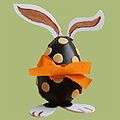
Chocolate Easter egg bunny
-
.jpg)
Giant easter egg, Argentina
-

Easter egg with candy.
-
.jpg)
Eggs made to be hung on trees
-
Marzipan Easter eggs in edible basket
-

Giant pysanka from Vegreville, Alberta, Canada
-
The Peter the Great Egg, commissioned by Czar Nicholas II as an Easter surprise for his wife.
-
Easter egg sculpture in Gogolin
-

Gladys as a Chocolate Easter Bunny with Easter eggs
Easter eggs for the visually impaired
Beeping Easter eggs are Easter eggs that emit various clicks and noises so that visually impaired children can easily hunt for Easter eggs.
Some beeping Easter eggs make a single, high-pitched sound, while other types of beeping Easter eggs play a melody.[38]
Since 2008, the International Association of Bomb Technicians and Investigators (IABTI) have sponsored a nationwide charity campaign in the U.S., building beeping Easter eggs every year for visually impaired children.
See also
References
- ↑ The Legend of Paschal Eggs (Holy Cross Antiochian Orthodox Church)
- 1 2 David Leeming (2005). The Oxford Companion to World Mythology. Oxford University Press. Retrieved 10 March 2013.
For many, Easter is synonymous with fertility symbols such as the Easter Rabbit, Easter Eggs, and the Easter lily.
- ↑ Neil R. Grobman (1981). Wycinanki and pysanky: forms of religious and ethnic folk art from the Delaware Valley. University of Pittsburgh. Retrieved 18 April 2014.
During the spring cycle of festivals, ancient pre-Christian peoples used decorated eggs to welcome the sun and to help ensure the fertility of the fields, river ...
- ↑ "Egg Cetera #6: Hunting for the world’s oldest decorated eggs | University of Cambridge". Cam.ac.uk. 2012-04-10. Retrieved 2013-03-31.
- ↑ Treasures from Royal Tombs of Ur By Richard L. Zettler, Lee Horne, Donald P. Hansen, Holly Pittman 1998 pgs 70-72
- 1 2 3 Donahoe's Magazine, Volume 5. T.B. Noonan. 1881. Retrieved 7 April 2012.
The early Christians of Mesopotamia had the custom of dyeing and decorating eggs at Easter. They were stained red, in memory of the blood of Christ, shed at His crucifixion. The Church adopted the custom, and regarded the eggs as the emblem of the resurrection, as is evinced by the benediction of Pope Paul V., about 1610, which reads thus: "Bless, O Lord! we beseech thee, this thy creature of eggs, that it may become a wholesome sustenance to thy faithful servants, eating it in thankfulness to thee on account of the resurrection of the Lord." Thus the custom has come down from ages lost in antiquity.
- 1 2 3 Vicki K. Black (1 Jul 2004). Welcome to the Church Year: An Introduction to the Seasons of the Episcopal Church. Church Publishing, Inc.
The Christians of this region in Mesopotamia were probably the first to connect the decorating of eggs with the feast of the resurrection of Christ, and by the Middle Ages this practice was so widespread that in some places Easter Day was called Egg Sunday. In parts of Europe, the eggs were dyed red and were then cracked together when people exchanged Easter greetings. Many congregations today continue to have Easter egg hunts for the children after services on Easter Day.
- ↑ The Roman Ritual. Part XI, Blessings and other sacramentals
- ↑ http://www.rachaelray.com/recipes/easter-meatloaf
- ↑ Anne Jordan (5 April 2000). Christianity. Nelson Thornes. Retrieved 7 April 2012.
Easter eggs are used as a Christian symbol to represent the empty tomb. The outside of the egg looks dead but inside there is new life, which is going to break out. The Easter egg is a reminder that Jesus will rise from His tomb and bring new life. Orthodox Christians dye boiled eggs red to make red Easter eggs that represent the blood of Christ shed for the sins of the world.
- ↑ The Guardian, Volume 29. H. Harbaugh. 1878. Retrieved 7 April 2012.
Just so, on that first Easter morning, Jesus came to life and walked out of the tomb, and left it, as it were, an empty shell. Just so, too, when the Christian dies, the body is left in the grave, an empty shell, but the soul takes wings and flies away to be with God. Thus you see that though an egg seems to be as dead as a stone, yet it really has life in it; and also it is like Christ's dead body, which was raised to life again. This is the reason we use eggs on Easter. (In days past some used to color the eggs red, so as to show the kind of death by which Christ died,-a bloody death.)
- ↑ Anderson, F.L.M., 1864, Seven Months' Residence in Russian Poland in 1868, London:Macmillan and Co.
- ↑ Krashansky Talerka.ru
- ↑ "dye-easter-eggs-naturally-without-a-box-onion-skins-beets-cabbage". /www.seriouseats.com. Retrieved 2014.
- ↑ "Natural Easter Eggs 3 Ways!/ with nylon stockings". natashaskitchen.com. Retrieved 2014.
- 1 2 A. Munsey Pu Frank a. Munsey Publishers (March 2005). The Puritan April to September 1900. Kessinger Publishing. p. 119. ISBN 978-1-4191-7421-6.
- ↑ "Pocking eggs or la toquette". Creolecajun.blogspot.com. Retrieved 2008-03-20.
- ↑ "If Your Eggs Are Cracked, Please Step Down: Easter Egg Knocking in Marksville". Retrieved 2008-03-20.
- 1 2 "Easter Eggs - Egg Rolling". Inventors.about.com. 2012-04-09. Retrieved 2012-09-24.
- ↑ "Easter Eggs: their origins, tradition and symbolism". Wyrdology.com. Retrieved 2008-03-15.
- ↑ Venetia Newall (1971). An egg at Easter: a folklore study. Routledge & K. Paul. p. 344. ISBN 978-0-7100-6845-3.
- ↑ "The End of Egg-cessive Easter Waste??". Waste connect. Retrieved 15 April 2014.
- ↑
- ↑ Today's Recipe from Our Files: Greek Easter bread, Tsoueki Judy Walker, NOLA.com |The Times-Picayune April 07, 2014
- ↑ Red and Butter, Martha Stewart magazine
- ↑ Ukrainian Egg Decoration: A Holiday Tradition by Ann Stalcup
- ↑ Воропай, Олекса. Звичаї Нашого Народу (Folk Customs of Our People) Київ: «Оберіг», 1993
- ↑ Manko, Vira. The Ukrainian Folk Pysanka L'viv, Ukraine: Svichado, 2005
- ↑ "Traditions of Great Lent and Holy Week". Melkite Greek Catholic Eparchy of Newton. Retrieved 2012-09-24.
- ↑ Terry Tempest Williams (Sep 18, 2001). Leap. Random House Digital, Inc. Retrieved 7 April 2012.
After the Ascension, she travelled to Rome and was granted entrance to the court of Tiberius Caesar. At dinner, she told Caesar that Jesus had risen from the dead. He did not understand. To explain, Mary Magdalene picked up an egg from the table. Caesar responded by saying that a human being could no more rise from the dead than the egg in her hand turn red. The egg turned red.
- ↑ Red eggs at Pascha Easter he Most Useful KNOWLEDGE for the Orthodox Russian-American Young People,” compiled by the Very Rev’d Peter G. Kohanik, 1932-1934.
- ↑ Easter Egg
- ↑ Easter
- ↑ Red Easter eggs
- ↑ Red eggs About.com
- ↑ "H2g2 - The Easter Bunny". BBC.com. Retrieved 2012-09-24.
- ↑ Article on the first Hen egg Archived October 16, 2008 at the Wayback Machine
- ↑ Tillery, Carolyn (2008-03-15). "Annual Dallas Easter egg hunt for blind children scheduled for Thursday". The Dallas Morning News. Retrieved 2008-03-27.
External links
| Wikimedia Commons has media related to Easter egg. |
| ||||||||||||||||||||||||||||||||||||||
